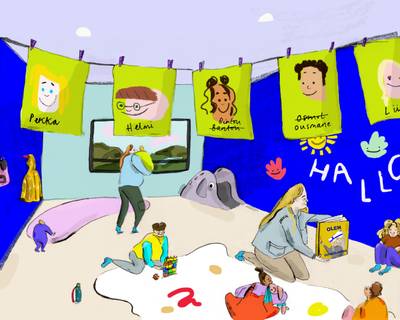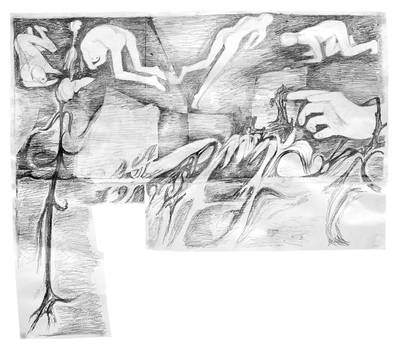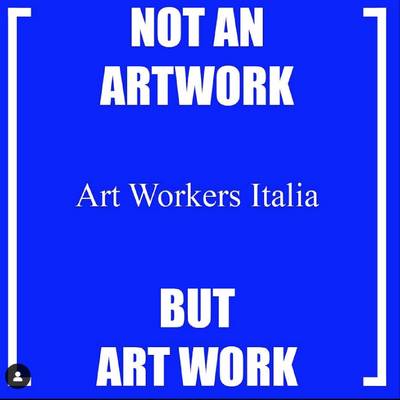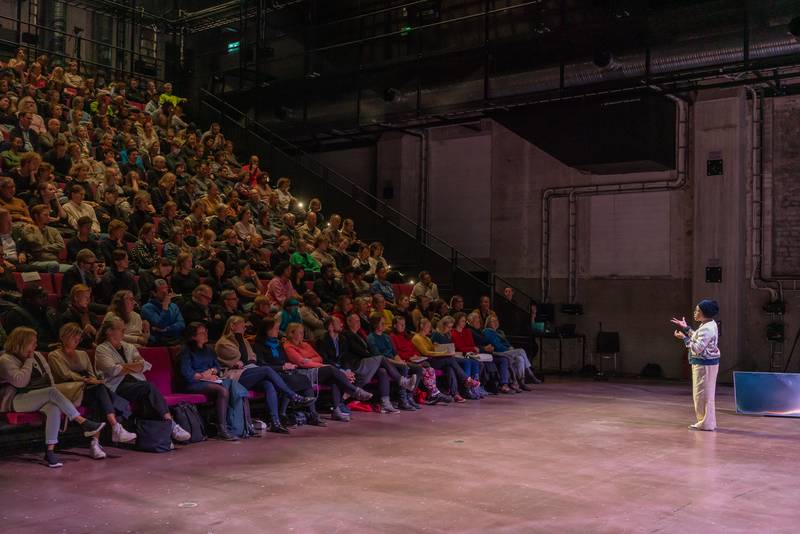

Sonia Boyce during the keynote lecture at Tanssin talo, Helsinki, 2022 | Photo: Petri Summanen
Milka Njoroge is a researcher and writer whose work focuses on how black people in Finland make space through various forms of cultural production.
Sonia Boyce likes to be surprised. Boyce admits this fact in several videos available online as she ascertains that improvisation and surprise have sustained much of her artistic work. This essay explores Sonia Boyce’s intense focus on acoustics to think about her recent Saastamoinen Foundation Keynote 2022: Oh – What Nonsense: exploring social play, improvisation and transgressions. Boyce’s visit was part of the fine arts internationalisation programme launched by the Academy of Fine Arts and the Saastamoinen Foundation in 2014 and was the sixth Keynote lecture in the programme. This essay thinks alongside black cultural productions in Finland and the sometimes-fraught dynamics that structure the relation between art institutions and black people.
In her award-winning installation, Feeling Her Way, the audience is immersed in a tapestry of geometric shapes with pictures that reflect the performances brimming from the screens. “I wanted other people to make noise,” says Boyce in an interview during the preparation of the show Feeling Her Way. Feeling by way of noise, sound, and mesmerizing geometric shapes makes Feeling Her Way stand out so much that it won the prestigious Gold Lion prize at the Venice Biennale in 2022. In my view, Sonia Boyce’s presence in Helsinki is complicated by Finnish institutions’ treatment of black people in Finland. This essay thus considers the conditions of possibility that Boyce’s presence catapults for black cultural productions in Finland. To be clear, I am not implying that for black cultural production to make sense in Finland, outside-Finnish-borders blackness needs always to be present; instead, I want to trouble this very tendency that many Finnish institutions seem to rely on.
On the one hand, the brilliant work of Sonia Boyce is what makes her visit to Helsinki so compelling, yet it also risks eclipsing small-scale black cultural productions in the Finnish context. As the event page of the University of Arts Helsinki notes, “The speaker of the annual Keynote lecture is a person with an international impact and wide recognition in the arts community…”. In this essay, I want to write against tendencies that reduce black people to the body. I want to think alongside small-scale gestures that contradict conscription into the national narrative. This essay attends to the refusals that black people engage with their relentless pursuits to think of alternative ways of living while Black in Finland. Furthermore, I want to contextualize Sonia Boyce’s cinematic Feeling Her Way as an instructive cinematic piece that contains affirming aspects of black cultural productions in Finland and provides lessons on how to create conditions that may not be easily capturable by state apparatus.
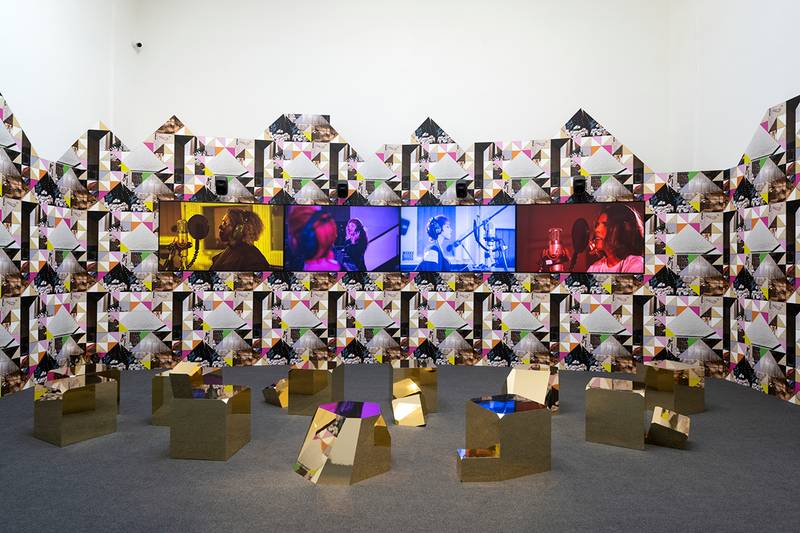

Room 1 in the British Pavilion featuring four performers - Errollyn Wallen, Tanita Tikaram, Poppy Ajudha, Jackie Dankworth, 2022 | Image: Cristiano Corte © British Council | Courtesy: © Sonia Boyce. All Rights Reserved, DACS/Artimage 2022
Let us begin. Sound is how Sonia Boyce creates a chorus that invites audiences to experience forms of sociality that are improvised, chaotic-not in a disordered manner, but that follows no rigid instructions or predicts its set of outcomes – and is mesmerizing – precisely because the set of outcomes cannot be predetermined. In several interviews that can be found online, Sonia admits the risks surrounding the artistic endeavours she sets out to do. Yet, black cultural productions have always been a feature of black diasporic populations. Both our survival and liberation have tended to rely on this modality. In tandem with Feeling Her Way, I am reminded of Finnish rap artist Yeboyah’s visual EP Elovena, which recreates a black femme sensibility that affirms its place in Finnish cultural aspects, nature being a defining part of this aspect. Elovena’s cinematic intervention inserts black and non-white people into Finnish nature, disrupting the myth of whiteness mediated by scenes of multiracial performers in the background. “I am a child of nature,”[1] proclaims Yeboah. “Natural child,”[2] another line follows. What captivates my attention with these lyrics is the affective response evoked here and the sense of obligation to demystify Finnish forests as a purely white phenomenon.
Nature in Elovena is a contested terrain that provides rest, care, and a mode of being in the world shaped by collectivity. Indeed, these modalities cannot be easily disentangled from the Christian doctrine that dictates mastery over everything living, including nature. Yet here I am arguing that if we attune our senses to feeling rather than depending on the superiority of sight, we might be able to unfix geographies from rigid orthodoxies. Elovena invites audiences to feel our way to Finnish nature in ways that attend to other forms of sociality. Elovena curates a femme sensibility, much of which is made up of the messy, inscrutable, and drama of black life in Finland. In my view, Boyce’s Feeling Her Way and Yeboyah’s Elovena are engaged in aesthetic practices that oblige the viewer to consider the relatedness and continuity of seemingly disparate projects. Specifically, my keen interest in Elovena is in how it defamiliarizes Finnish landscapes through the mobilization of (black) femme sensibility. Here, my use of black femme borrows from Kara Keeling’s conceptualization of the black femme, not as an identity category but as an investigation of how gender, sexuality, race, and place make available alternative communities and ways of being.
Feeling Her Way and Elovena provide care and rest for black people and migrant laborers whose presence in Finland is dominantly mobilized for the longevity of the welfare state. Sonia Boyce’s work invites us to relax our gaze and heighten our listening and feeling in ways that contradistinguish dominant national imaginaries that obscure those who cofound dominant logics of bodies, desires, and affiliations.
Yeboyah - Elovena
Feeling Her Way and Elovena provide care and rest for black people and migrant laborers whose presence in Finland is dominantly mobilized for the longevity of the welfare state. Sonia Boyce’s work invites us to relax our gaze and heighten our listening and feeling in ways that contradistinguish dominant national imaginaries that obscure those who cofound dominant logics of bodies, desires, and affiliations. In an interview with the Manchester Art Gallery, Boyce emphasizes that she considers her artistic practice “research”, observing what unfolds when she combines different elements. Her practice involves “recontextualizing” various elements to perhaps throw into crisis what we think is stable, fixed, and predetermined. Elovena does precisely this. Yeboyah maps alternative gender, racial and sexual formations onto the Finnish landscape to collapse the boundaries between art, sound, and creativity. In Feeling Her Way, noise allows Sonia Boyce to improvise along the lines of call and response that manifest through song and sound. The performers in Feeling Her Way are invited to explore forms of sound that do not confine themselves to recognizable sonic formations, thus making available to audiences an audio-visual experience that is sustained by affiliation, encounter, and indeterminacy. Performers of Feeling Her Way are encouraged to produce a guttural sound that mimics the roar of a lion. Each performer builds on the other. A guttural roar fills the room, each joining the other yet remaining distinguishable from the other. In this space, the musicians are in conversation with each other. Each picks up where the other left. They create a harmonious rhythm that inscribes Boyce’s vision of surprise and improvisation.
Boyce’s schemata explores artistic frames that improvise towards exploring the coupling of technological processes and human voices. In my view, Boyce’s practice draws on a Black Atlantic tradition that casts black sounds to a wider net in ways that come to terms with difficult histories of slavery and colonialism. As Boyce demonstrates, her keen interest in jazz skat, specifically looking at Adelaide Hall, a jazz musician from the 1930s who had immigrated from the US to the UK, emphasizes the counterculture that dance and noise engender. In 2010, Boyce directed Oh Adelaide, a 7-minute film that combines a cacophony of sounds, Adelaide Hall’s dancing to Duke Ellington’s playing the piano, and indecipherable sounds playing in the background. Here the glitching sound engenders noise and a refusal for intelligibility to produce a sound spectrum that travels throughout the 7-minute duration. Following Boyce’s sustained practice, Oh Adelaide plays with sound, images, and light to articulate black life’s cultural, political, and epistemological architecture. Several generations later, Yeboyah is traversing this same space and mobilizes audio-visual sensibilities that step outside constricting limits of blackness in the Finnish context to join the chorus of the black sound archive of Finland. In my view, Sonia Boyce’s presence in Finland, though sheltered from the everyday realities experienced by black people in Finland, reverberates throughout the black diaspora in Finland to join discourses of cultural production and the intertwining of domination and the negotiation of space and geographical landscapes.
Feeling Her Way is a call to experience the world through situating oneself in a non-chronological time-space that accommodates uncertainty. In Elovena, the black femme sensibility enlivens varied sites of inquiry that critique white supremacist, cisheteropatriachy tendencies that relegate black people to urban centers, which are beholden to protocols of domination and dispossession. That is, black and other non-white groups are subjected to continuous labour in the form of caring and cleaning jobs.
Reflecting on the relationship between Finnish arts institutions and black people in Finland, I am left wondering whether we will need to reconfigure our alienation through affirmative ways that render our presence, musicalities, and cultural productions as always outside the bounds of the Finnish nation-state. While Elovena evoked uneasiness the first time I encountered the audio-visual, multiple viewings reveal the unfolding of practices of survival that are not isolated but indeed predicated on a long history of Afro-diasporic sensibilities that have long been anthems of liberation, insurrection, and vernacular practices. Perhaps my unease stems from the alienation I’ve long felt in Finnish nature. Though nature is deemed to be a universalized space where anyone can go to find reprieve, the ways in which Finnish nature is conceptualized intensifies feelings of alienation, strangeness, and Othering. These feelings are not just psychic but are shared by other black people, thus creating an empirical experience that hinders our ability to be in Finnish nature. Yeboyah’s Elovena chafes at this feeling of alienation by establishing Finnish forests as conduits of rest, play, and conviviality. Elovena counters the logic of the labouring migrant body by intensifying our capacity to be outside of the neoliberal frames that continually demand that we genuflect at the feet of the Finnish nation-state. Elovena’s audio-visual force engenders practices of solidarity as weapons against tendencies that exceptionalize the black story.
Similarly, Feeling Her Way is a call to experience the world through situating oneself in a non-chronological time-space that accommodates uncertainty. In Elovena, the black femme sensibility enlivens varied sites of inquiry that critique white supremacist, cisheteropatriachy tendencies that relegate black people to urban centers, which are beholden to protocols of domination and dispossession. That is, black and other non-white groups are subjected to continuous labour in the form of caring and cleaning jobs. Elovena thus articulates a politics of inscrutability with possibilities to reproduce a counterhegemonic narrative. Just as Sonia Boyce’s preoccupation with jazz skat is embedded in the dense strata of histories, imaginaries and memories expand throughout the black diasporic populations. Jazz skat establishes a dialogue between sound, popular culture, and black cultural technologies to speak to contemporary black culture’s crucial pace of sound. I view this influence as not explicitly replicated in Elovena but instead culminating in the rhythm, the materiality of the audio-visual, and the privileging of cultural spheres. Here, cultural spheres are murky as the Finnish forests are not seen as the domain of non-white peoples. Hence, in my view, Elovena is important in throwing this belief into crisis to generate unexpected meanings and dispositions for black life in Finland.
Sonia Boyce’s practice is exacting, open-ended, affective, and relational in ways that, in my view, enable the artistic creativity of Yeboyah. These transgenerational cultural influences ponder what it means to engage in a counterhegemonic cinematic process. Boyce’s presence in Finland advances a localized and black diasporic formation that emphasizes black people’s subjectivities in an environment that continuously disregards and downplays our presence.
As Paul Gilroy makes clear, matters of antiblackness and racial injustice are not simply rhetorical and metaphoric. Black cultural productions ground their musicalities in undoing colonial and racist common sense. Black cultural productions create counter-discourses that heighten the frame of sound and listening to suggest new ways of thinking about black life in Finland. Though we might think of black cultural productions in Finland as still in their nascent stage, they sit squarely in the tradition of the black Atlantic world. Through the intensities of encounter, difference, alienation, and strangeness, Elovena maps itself to black popular culture to communicate a political investment in black life. Similarly, Sonia Boyce’s practice is exacting, open-ended, affective, and relational in ways that, in my view, enable the artistic creativity of Yeboyah. These transgenerational cultural influences ponder what it means to engage in a counterhegemonic cinematic process. Boyce’s presence in Finland advances a localized and black diasporic formation that emphasizes black people’s subjectivities in an environment that continuously disregards and downplays our presence.
I do not wish to rehearse the representation discourse as this recapitulates the pithy pretensions and promises that Finnish institutions are not ready to honour yet. At Sonia Boyce’s suggestion, I insist on thinking about black cultural productions in Finland in unexpected spaces. Spaces which are mediated by noise or alternative audio-visual technologies. Spaces that perhaps are not, luckily, available to the hegemonic eye.
While this essay focuses on only one iteration of black cultural production in Finland, it is by no means the only one. Black people engage in minor frequencies of cultural production that defy the Finnish logic of isolation. Black people conspire at this threshold while resorting to contingent and improvised ways of living. This is Sonia Boyce’s mandate. To push audiences towards an indeterminate place while remaining faithful to the impetus of black cultural productions. Both Feeling Her Way and Elovena offer audiences interconnected yet heterogeneous aesthetic practices that can transform our audio-visual experiences.
